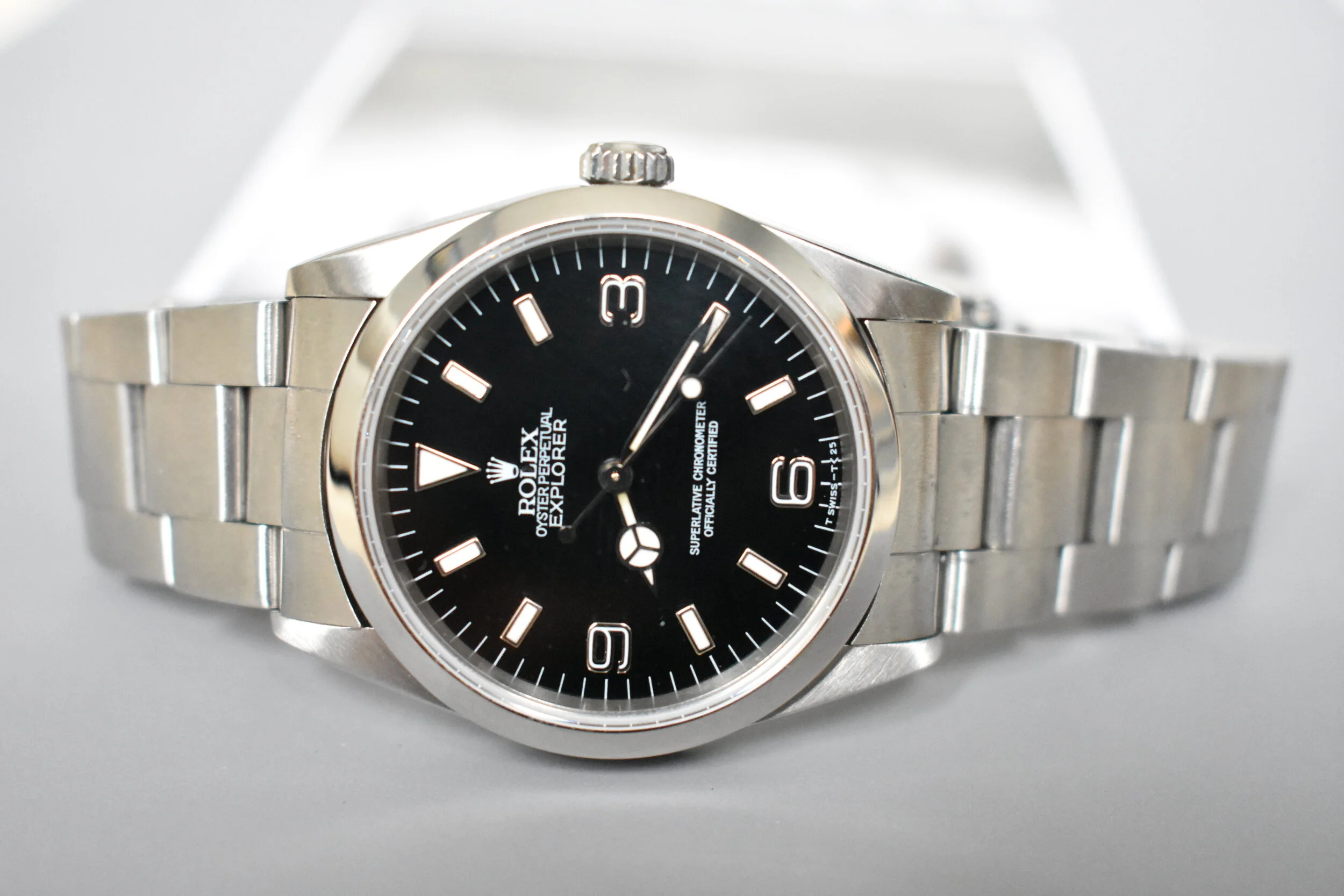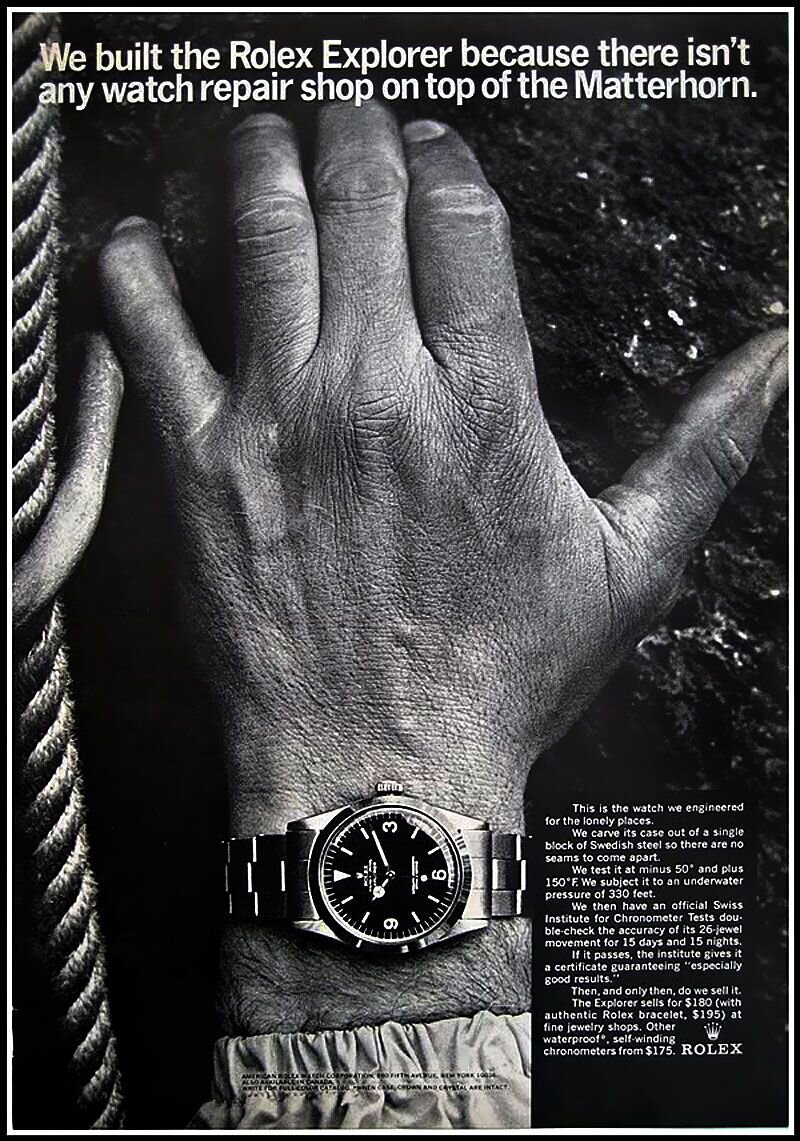Often flying under the radar, the Rolex Explorer is the most understated of Rolex’s various sports watches. It’s less bulky than a Submariner and less flashy (and expensive) than a Daytona, leading some to call it the perfect every-occasion watch. Originally conceived after Sir Edmund Hillary and Tenzing Norgay became the first individuals to summit Mount Everest in 1953, the Explorer design has remained remarkably unchanged by Rolex, while still offering enough variety for collectors to be endlessly intrigued.
Pre-Explorer and Exploring Everest (Kind Of)
For almost every great human achievement of the 20th Century, there’s a watch that lays claim to being on the trailblazer’s wrist. Trips to the moon, Olympic gold medals, and of course, the expedition to summit Mount Everest. Many now know it’s a myth that Tenzing Norgay and Sir Edmund Hillary were wearing Rolex Explorers when they first summited Everest in 1953, but that didn’t stop Rolex from cashing in on a killer marketing opportunity. Rolex had indeed been testing watches on Himalayan expeditions since the 1930s to ensure they could keep perfect time at -50°F and 70% less oxygen than at sea level, but these timepieces did not yet bear the Explorer name, nor its signature 3-6-9 dial or Mercedes hand. Instead, these watches were modified Oyster Perpetual models.
On the historic 1953 summit climb, Hillary wore a Rolex and a Smiths, endorsing both watches. After the successful summit, Rolex quickly launched its Explorer line to commemorate (and profit) off of Norgay and Hillary’s amazing feat. In 1953, Rolex first launched the Reference 6298. While the black 3-6-9 dial can be seen in some Ref. 6098 and Ref. 6298 cases, these references are more known for their creamy “Everest” versions, some having Arabic numerals and some having wedges.
Explorer 6350 with honeycomb dial | Phillips
Soon after in 1953, Rolex officially rolled out the black 3-6-9 dial in Reference 6150 and Reference 6350. The only difference between the two was that the 6350 was chronometer rated and stamped as such on the dial, while the 6150 is stamped “precision” (note though, that they had the same A296 movement, but the 6350 was more finely tuned). Especially rare, some 6350s sported a beautiful “honeycomb dial.” The Ref. 6350 was the first model with the “Explorer” moniker on the dial, making it the first “real” Explorer. As such, all references before the 6350, are often dubbed “pre-Explorer.” As mentioned, all of the pre-Explorer references do not sport uniform dial layouts the way all true Explorer references have the 3-6-9 Arabic numerals.
A few years later, there were also some Reference 5504 Explorers cased – this case reference was also used for the Air King at the same time (both were 34mm models). There was also an Explorer Date released around this time, Reference 5700. On this reference, even the dial looks like an Air King in all ways except for the “Explorer Date” stamped above the pinion.
Rolex Explorer Reference 6610
The Explorer began to truly differentiate itself from the Oyster Perpetual line in 1959 with the introduction of Reference 6610. It had all the classic hallmarks of an Explorer: stainless steel oyster case measuring 36mm, black dial (gilt dial in this case, now highly desirable), 3-6-9 numerals, a reverse triangle at 12 o’clock, and a Mercedes hour hand. An especially rare variant of the 6610 is a “red depth indication” model, which has the water resistance (50m) printed in red under the Explorer moniker on the dial. You’ll also find some variants with the water rating printed in white. Ref. 6610 used a new calibre 1030 movement, which allowed the Explorer to shed the bubble back it’d been sporting up until this point. Because the 6610 had such a short production run, it’s a relatively rare find.
Rolex Explorer Reference 1016
A matte dial Explorer reference 1016 | Hodinkee Shop
Of course, the most well-known Explorer is Reference 1016. In production from 1963 until 1989, it went through some small changes, but stayed remarkably true to the signature Explorer look established by the 6610. The 1016 packed a new movement, the calibre 1560, which became a signature movement for Rolex sports watches in the 1960s. In the early 1970s this movement was slightly improved upon when Rolex began using the calibre 1570, which featured a hacking seconds hands. The 1016 also rated to 100m water resistance, an improvement over the 6610.
As is this case with other vintage Rolex watches, early examples of the Explorer 1016 have glossy black dials with gilt details (meaning the font is now a warm golden color). By the late 1960s, Rolex began introducing matte black dials with a crisp white font. Gilt-dialed 1016s are the most sought after by collectors, frequently reaching prices above $20,000.
Right around the time the 1016 was released, Rolex was also transitioning the luminous material used on its hour markers. Up until this time, it had used radium, which had been discovered to have detrimental health effects. So, Rolex began using tritium, a safer option. This was signified by the printing of “T Swiss T” or “Swiss T<25” on the dial in place of the traditional “Swiss.” Thus, earlier Explorer (and more desirable) dials may have “Swiss” written below the 6 o’clock position.
Other collectors’ favorites of the Rolex Explorer Ref. 1016 include the “Space Dweller,” realeased only in Japan. An Explorer in every other way, it’s stamped with the words “Space Dweller” where Explorer would otherwise be.
Into the Modern Era: Reference 14270 and Reference 114270
In 1989, Rolex finally discontinued Ref. 1016, modernizing the classic Explorer with the release of Reference 14270. The new reference updated the late 1016's matte dial with a glossy dial and white gold surrounds on the applied indices. The 14270 did stay true to the original Explorer's 36mm diameter, albeit with a new Caliber 3000 movement inside. The case was also bigger and beefier, bringing it into the modern era. Additionally, the acrylic crystal of the 1016 was also replaced with sapphire glass, another thoroughly modern feature.
While the 14270 isn’t sought after by collectors the way a 1016 might be, there is one exception: the Explorer Blackout. Produced for a short amount of time in the early 1990s, the Rolex Explorer Blackout had black Arabic numerals instead of white. If you’re searching for one, look for a serial number in the E (or perhaps early X) range. And good luck finding one. In the more common version with white indices, the indices were filled with tritium, until 1997-1998, when Rolex began using Super Luminova as luminous material. You can tell the difference by looking at the dial: if tritium was used, the dial will say “T Swiss - T < 25” below the 6 o’clock marker. To many, the Ref. 14270 is the perfect blend of form and function: it hadn’t yet fully evolved into a completely modern fashion piece and stayed true to the classic Explorer look, while still adding details that elevated the Ref. 1016: white gold surrounding the indices and a new modern movement among them.
The Rolex Explorer Reference 14270 “Blackout”. | HQ Milton
In 2001, Rolex updated the Ref. 14270 with the Reference 114270, which housed a new calibre 3130 movement. This made the 114270 0.5mm thicker than the 14270 (12mm v. 11.5mm), but other than that, the two watches are the same. The next big change for the Explorer came at Baselworld in 2010.
The Explorer Gets Big: Reference 214270
The newest Explorer, Ref. 214270, first came to the market in 2010. It features a 39mm Oyster case, a welcome update for those who wanted something more modern than the traditional 36mm size used in all references up to 2010. But, the 214270 was met with mixed reviews when released. Many had issue with its short hands, which seemed to be the same length as the hands in the 14270, even though the case was 3mm bigger. To many, this led to an unsightly dial, defeating the benefits of the increased case size. Subsequently, Rolex released an updated 214270, this time with longer hands. The newest version is often referred to now as the Mark 2, or Mk2, with the original 2010 release being Mark (Mk 1).
The Ref. 214270 also houses a new movement, the in-house calibre 3132, which runs to +/-2 seconds a day and is COSC certified.
The 2016 re-release of the Rolex Explorer 214270 | Bob’s Watches
Rolex Explorer Quick Guide
In summary, the Rolex Explorer family is made up of a number of superlative references, including:
Reference 6350, the first Explorer (honeycomb dials especially desirable)
Reference 6610, the first truly differentiated Explorer, introduced in 1959
Reference 1016, the most common vintage Explorer, highly desired (especially with a gilt dial)
Reference 14270 (and Reference 114270), the 1989 update that brought the Explorer into the modern age
Reference 214270, the 2010 update which bumped the case size to39mm.
The Rolex Explorer is the “Rolex for people who don’t like Rolex,” but is so appreciated by enthusiasts and casual observers alike, it’s likely just beginning its expedition.






